21 Who identified the Developmental Affirmations?
Jean Illsley Clarke and Connie Dawson, with the help of developmental theorists and of many, many more people, identified the Developmental Affirmations. Connie Dawson devised the whole Integration set for the Preparing for the End of Life stage.
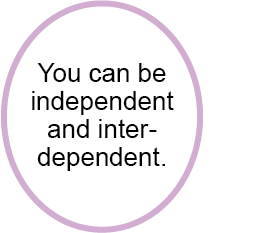
You can be independent and interdependent.
Interdependence — Stage 7
*
DIGGING DEEPER: read about other contributors.
Carole Gesme tracked and tested the Affirmations through each developmental stage.
Some of the messages were gifts from people who recognized a hole in the stages lists or who helped to find the right words. Elaine Childs Gowell contributed, “You can trust your intuition to help you decide what to do.” (Structure, Stage 5).
During workshops in Europe, Australia, New Zealand, America, Canada and Asia, participants offered many suggestions.
Through the years, countless numbers of people have offered ideas and wording, and we (Jean Illsley Clarke and Connie Dawson) are deeply grateful to you all.
The origins of the affirmations are described in detail in the article “The History of Affirmations: Give us words,” WE Volume 6 Issue 4.
*
*
The History of Affirmations: Give Us Words
by Jean Illsley Clarke (WE Vol 6, No.4)
“We all want to be good parents, but we don’t know how. Put words in our mouths.” My husband Dick stopped by my desk, put his hand on my shoulder, and made that request several times while I was writing “Self-Esteem: A Family Affair.” He may have thought he was doing that for himself, but it always helped me focus on the purpose of the book. Words. Where would I find those words? I needed them myself. Not generalizations, not admonitions, not vague theory, but specific target words, bare bones words that would help me remember what I was supposed to be doing as a parent.
I walked in the daytime and tossed and turned at night trying to get my mind around those words. Gradually they began to take shape. Words to build self-esteem, but those words are not enough. What if we had a set of words with special ways to say you are lovable and capable at each age? What if we also had words for each developmental stage to tell parents what to do, what to celebrate, what to insist upon, what to give permission for? That would be good. It would be even better if both of those needs could be wrapped into one set.
I had read Sondra Ray’s “I Deserve Love,” (1976), the only affirmation book on the shelves at that time, and I knew that what I wanted was a set of developmentally based affirmations. I knew I could formulate those words, but I also knew it would take a long time. The publisher was pushing for the manuscript and most of the pieces of “Transactional Analysis” (Berne, 1961) theory that I wanted to translate into lay language were in place. Each chapter/story focused on one development stage and the theory pieces were chosen to support growth in that stage.
Naming the Stages
I had decided on the age/stage designations — 0 to 6 months as first stage and 6–18 months as the second, rather than Erikson’s (1964) 0–18 month “Basic Trust versus Mistrust” stage, because the experience of parenting a baby who stays in one place versus one who gets into everything demands different skills.
Parents helped me name the stages. I was teaching parenting classes while I was writing the book. The people I was working with didn’t find stage titles such as “Industry versus Inferiority” or “Object Constancy” easy to remember, so I searched for simple, lay, task designators. Parents in several classes were willing to think about how words reflected what they experienced with their children. We finally settled on:
- Being (0–6 months)
- Doing (6–18 months)
- Thinking (18 months–3 years)
- Power & Identity (3–6 years)
- Structure (6–12 years)
- Identity, Sexuality & Separation (adolescence)
I know the names are not parallel word forms, but they work.
So, the Transactional Analysis theory pieces and the stage names were in place, but I needed the affirmations in order to finish the stories.
Beginning Affirmations
Then, one bright day, I found Pamela Levin’s therapeutic “permissions” in her 1974 book, “Becoming the way we are: A transactional guide to personal development.” There was a set for each of the stages of childhood, but none for adults. I knew that, strictly speaking, some of the messages were not affirmations. They contained some “don’ts” and they didn’t have as many love messages as I wanted, but they were a wonderful start. I took Pam’s messages to my classes and the parents said, “Yes! Let us have them!”
When I asked Pam if I could use her permissions as affirmations for parents, she said, “I have never thought of using them that way!” She was enthusiastic and supportive, and her permissions were published as affirmations in the “Self-Esteem: A Family Affair” book in 1978. In a postface to the book I explained the meaning of each permission when used as an affirmation. They were also featured in the “Self-Esteem: A Family Affair Leader Guide” (1981).
Recycling Theory
In that book I wrote about recycling. We are, according to the theories put forth by Erik Erikson (1959, 1964), stimulated by some natural rhythm of growth to upgrade earlier developmental tasks throughout our lifetime. Pam Levin named this process “recycling” and it is a theory that fits my life experience. As a therapist, Pam observed that people are triggered to recycle earlier stages by life events such as starting a new job, losing a friend, marriage, divorce, or death of a loved one. I, as a parent educator, noticed that people are also triggered by their children to recycle a stage their child is growing through.
Affirmations for Adults
Pam’s messages are very supportive of the tasks and experiences of adult recycling, and although I personally used the messages to support my own recycling, I also needed a set of adult level affirmations. I remembered the work of Havighurst and Erikson (1959) which had made such an impression on me a decade before, and added the then-current work of Levinson (1978) and McGill (1980). Fortunately, I was able to attend a conference on adult development at the University of Kansas. I listened avidly to a variety of researchers and theorists on adult development and checked out my affirmations for adults against those several theories. Although the presenters were prestigious and included names like Gould, Freund-Lowenstein, and Stokes, I confess I was single-minded about my task and paid far more attention to whether the theories helped make sense of my affirmations than to just who said what.
Developing the Educational Developmental Affirmations
At the same time I was working on the adult affirmations, I was collecting affirmations for children. As I worked with a broad socioeconomic range of parents, I felt pushed to create affirmations that did not include “don’ts” and that did not need interpretation.
I was working slowly, wanting to be sure they were “right” and knowing there was no real way to be sure. The push to finish came from a mom in December 1985. I reported it in the September 1986 issue of my newsletter, WE.
I recall with discomforting clarity the night I was doing a workshop for parents and students in a junior high school. I has posted an early rendition of two sets of affirmations for the stages “Being” and “Structure.” It was not long before Christmas. One Mom rushed in, sank into a chair and said, “Well Jean, what good stuff do you have for us tonight?” I pointed to the posters. She read, “You don’t have to hurry,” and snorted, “That’s a lie!” Then she read, “You can do it your way,” and sighed, “That’s another lie.” I said, “Wait, let me explain what those mean.” “I’m busy,” she exploded, “Why don’t you say what you mean in the first place?” “I’m working on that,” I mumbled. “Well,” she pushed, “make it top priority.” I did.
There were many sources and contributors to my work:
- My own children and their friends
- Memories of readings from the Gesell Institute (1974), that had been helpful as I was raising my own children. However, I enjoyed my own 2-year-olds, so I never could stand the idea of the “Terrible Twos” and I’m proud that my developmental audio tape is called “The Terrific Twos” (Clarke, 1981)
- My own life experiences, remembered or recalled through regressive work
- The wisdom of therapist friends who worked from a developmental model, especially Pam Levin, Elaine Childs-Gowell, Jean Wiger, Russell Osnes, Maggie Lawrence, Gail Nordeman and Jean Maxwell
- My reading of several developmental theorists including Selma Fraiberg (1959) and Naomi Golan (1981). The Series of Comparative Charts of Psychological Theory — No 1: Child Development, researched and compiled by Val Magner, helped me sort and compare the ideas from Mary Sheridan, Jean Piaget, Sigmund Freud, Anna Freud, Melanie Klein, Erik Erikson, Mavis Klein, Jacqui Schiff and Pam Levin
I called the resulting six sets of developmental affirmations for children Educational Affirmations. They are designed to be used as first-time-around messages. That they turn out to support adults in their recycling tasks is a bonus.
Testing the Affirmations
The affirmations were tested for about two years. I gave them to parents and adjusted wording in response to parents’ questions and suggestions. Preschool teachers, school teachers, children and adolescents also tested them. I kept charts to be sure that each set was examined by five or more testers. People were willing to help. It was wonderful.
When the entire set was almost finished, it felt as if there was one hole in the adult affirmations and I still needed to do a final test of the whole set with a young adult. Serendipity. My son Wade was 23 at the time and he wanted to borrow my car for a trip east. My offer: If he would drive me to a conference in Chicago and would work on the affirmations on the way, he could use my car. Deal! It was fascinating. Between us we designed a model for examining each affirmation in a variety of ways from his young adult perspective. He chose five young adult friends whose personalities and family situations varied widely and whom he knew well. One friend at a time, we went through each affirmation with these questions:
- How strongly does he/she hold this belief now?
- If strongly, how is that reflected in his/her life now?
- What effect might that have on his/her life 15 years from now? 30 years from now?
- If it is not a strongly held belief, how does that affect his/her life now?
- If he/she continues in that disbelief, what effect will that have on his/her life 15 years from now? 30 years from now?
This exercise consumed the whole eight hour drive and we entered Chicago with his stamp of approval on all 53 affirmations, but with agreement that something was still missing from the adult set.
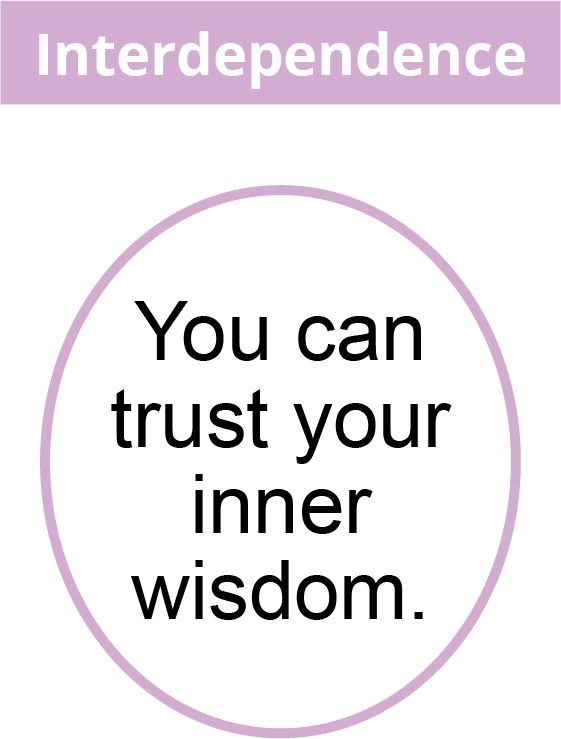
I said goodbye to my son and found my way into the conference venue, confident that I would soon see someone I knew. My friend, Elaine Childs-Gowell, rushed up to me with these words: “Jean, I have a new affirmation: You can trust your inner wisdom!” Laughter, sigh, relief, thankfulness. The missing affirmation. Elaine welcomed me to insert it in my list. Interestingly, the adult affirmations were handwritten and there was a space at the point where the new affirmation fit perfectly in the flow of messages.
The Educational Affirmations were first published in 1986 in the September WE and in the six “Help! For Parents” books (Clarke, 1986) that I co-authored/edited with 18 parent educator colleagues. Those books have now been combined into two volumes, “Help! For Parents of Children from Birth to Five” and “Help! For Parents of School Age Children and Teenagers” (Clarke, et al, 1993).
COMPARISONS — You Affirmations Versus I Affirmations
The major difference between the Educational Affirmations and other sets of affirmations, besides the developmental base, is the use of you instead of I. The theory behind I affirmations is well known: get a person to repeat an “I am …” message enough times and the belief will set in and override the old message that said, “I’m not …” I have never been comfortable with one person telling another to say, “I am …” Berne’s Ego State theory from his 1961 book “Transactional Analysis” helped me to understand and articulate my discomfort.
Let us say, as an example, that I have a deep belief that I do not belong, then you tell me to say “I belong here” twenty times a day. I object.
- First — No matter how much goodwill you have toward me, this is your message, not mine.
- Second — Saying your prescribed “I belong here” can set up dissonance in me and even more anxiety, discomfort or depression than I had before.
- Third — If I try to say it and give up, I have added another failure, another proof that I don’t belong here.
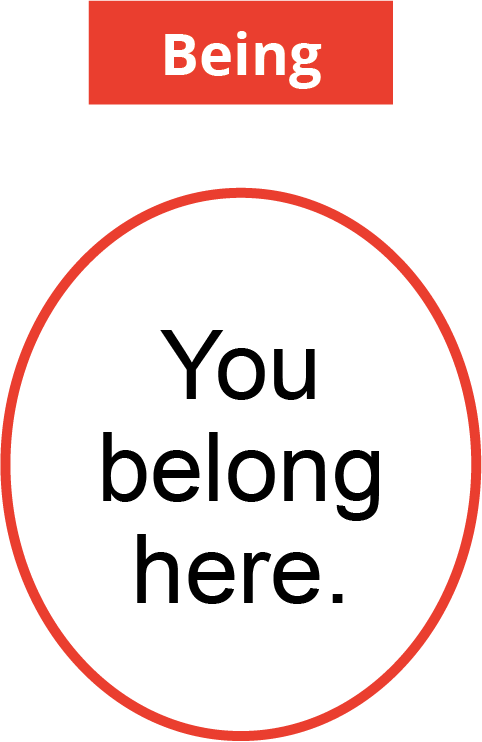 If instead you say to me, “You belong here,” I can listen to you with all three of my Ego States: Parent, Adult and Child. My Parent Ego State might say, “She seems to mean that!” My Adult might say, “It seems reasonable that I ought to belong here.” My Child can say, “No way!” But the thinking, the internal dialogue between the Ego States, has started. Then if the Parent says, “This fits with my values,” and my Adult says, “This seems to be a healthy message,” the affirmation now belongs to me. I have chosen it. I can say to my child within, “You belong here.” My Child can argue or disbelieve, but if my Parent and Adult Ego States unite to insist on giving the message and deliberately choose to behave as if I belong here, eventually my Child will spontaneously say, “I belong here.” The belief will not be secure at first, but with constant Parent and Adult reinforcement, the belief will come. If this does not happen, it is a sign that I need more than self-affirmation. I need the added strength and wisdom of a counselor or therapist.
If instead you say to me, “You belong here,” I can listen to you with all three of my Ego States: Parent, Adult and Child. My Parent Ego State might say, “She seems to mean that!” My Adult might say, “It seems reasonable that I ought to belong here.” My Child can say, “No way!” But the thinking, the internal dialogue between the Ego States, has started. Then if the Parent says, “This fits with my values,” and my Adult says, “This seems to be a healthy message,” the affirmation now belongs to me. I have chosen it. I can say to my child within, “You belong here.” My Child can argue or disbelieve, but if my Parent and Adult Ego States unite to insist on giving the message and deliberately choose to behave as if I belong here, eventually my Child will spontaneously say, “I belong here.” The belief will not be secure at first, but with constant Parent and Adult reinforcement, the belief will come. If this does not happen, it is a sign that I need more than self-affirmation. I need the added strength and wisdom of a counselor or therapist.
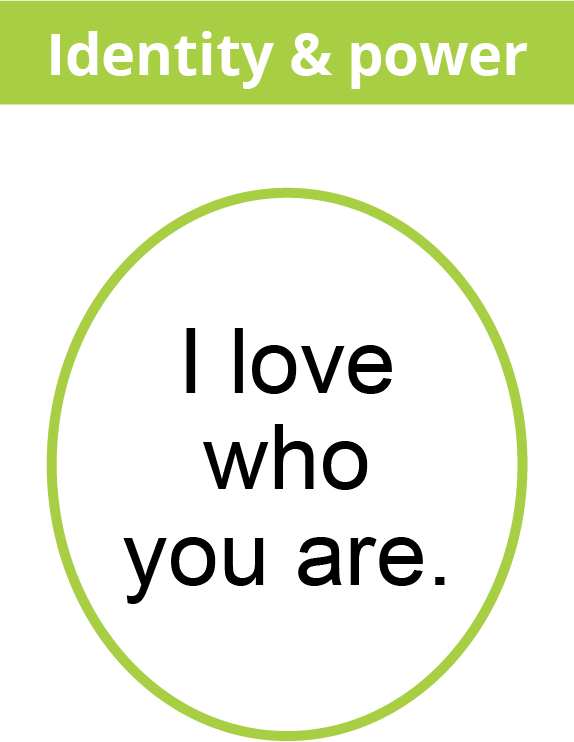 You does not always start the affirmation message. Sometimes it says “I feel this for you,” as in “I love who you are.” That is very different from telling someone to say “I love who I am”.
You does not always start the affirmation message. Sometimes it says “I feel this for you,” as in “I love who you are.” That is very different from telling someone to say “I love who I am”.
I feel strongly about the presumptuousness of telling people to say, “I …”. It is one of the reasons I was first attracted to Pam Levin’s (1974) you messages.
The Love Affirmations
The 54 educational affirmations include a message for each stage that says, “I love you and support your tasks in this developmental state.” Unconditional love for being the age you are!
- I love you and I care for you willingly. (0–6 months)
- I love you when you are active and when you are quiet. (6–18 months)
- You can become separate from me and I will continue to love you. (18 months–3 years)
- I love who you are. (3–6 years)
- I love you even when you differ: I love growing with you. (6–12 years)
- My love is always with you. I trust you to ask for support. (12–18 years)
- Your love matures and expands. (adult)
- You are lovable at every age. (adult)
These special love affirmations were described in the February 1987 WE and later in the “Affirmation Ovals, 139 Ways to Give and Get Affirmations” (1988) book that Carole Gesme and I wrote.
The Love Game
Carole Gesme saw the power in and the need for the love affirmations and decided to make them available in a potent way. Using a Monopoly-type board, Carole created The Love Game in 1988. It is spectacular. People who might have trouble saying or hearing the love messages can manage it when they are rolling dice, moving markers, and drawing activity cards. Playing the game the whole way through (about an hour), or even for 10 minutes, gives one a bath of unconditional love messages that creates a soothing and healing experience. The Love Game is widely used not only by families but also in adolescent treatment centers
Carole is an inventor of games and she was already using the affirmations in her games Ups and Downs With Feelings — Ages 6 to Adult (1985) and Ups and Downs With Feelings — Ages 3–6 (1985).
Ways That Affirmations Have Been Used
In addition to their use in books, in journal articles, and in puzzles, there are as many ways to use the affirmations as your imagination and creativity present.
Since 1985, Carole Gesme has been offering the affirmation messages in rainbow colored ovals in a variety of sizes. These are easy to carry in your pocket and to play games with. The stickers come in ovals and also in fanciful figures. The latter were developed in response to teachers who wanted engaging stickers to put on students’ papers. On earlier versions, the recommended ages of focus for each set of tasks was included on the ovals. When junior high age children refused to use ovals with younger ages on them (declining to understand the concept of recycling), Carole removed the ages. Adults can easily remember the stage ages by relating them to the sequence of colors in the rainbow.
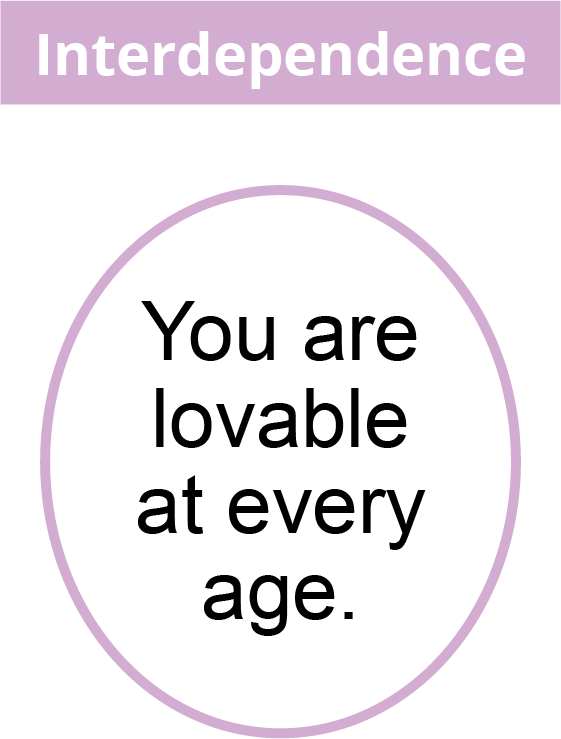 A teenager put large love ovals on her bedroom ceiling to remind herself that she is lovable in spite of acne and adolescent ups and downs.
A teenager put large love ovals on her bedroom ceiling to remind herself that she is lovable in spite of acne and adolescent ups and downs.
The affirmation posters hang on the walls of a high school special education room. A student asked that the poster be moved higher on the wall so he could see them all from his seat.
On the first day of school, fifth graders found large love ovals placed cleverly in their room. “You belong here” was on the door. “You can grow at your own pace” was in the plant. “What you need is important to me” was over the water fountain. During the following weeks other sets were similarly presented.
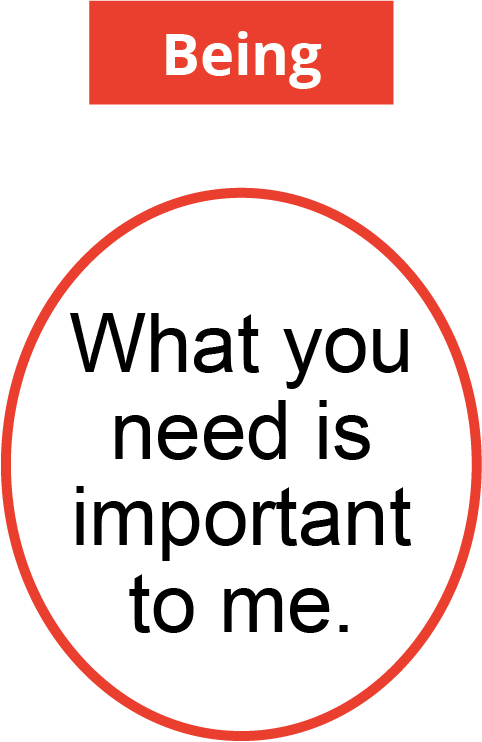 A middle-aged woman was introduced to the affirmations in a workshop. She thought, “I’m doing just fine as an adult, but I’ve never heard most of those messages. I want to find a way to get them.” She used them to help heal the residue from having grown up in a family with alcoholism.
A middle-aged woman was introduced to the affirmations in a workshop. She thought, “I’m doing just fine as an adult, but I’ve never heard most of those messages. I want to find a way to get them.” She used them to help heal the residue from having grown up in a family with alcoholism.
The “Being” affirmation poster hung on the wall of the hospital room. Whoever came into the room pulled an affirmation from the bowl on the dresser or chose one from the poster and read it to the patient during his last months of Lou Gehrig’s disease.
Parents put large love affirmation ovals on the walls of the nursery to remind them about what the baby needs.
A teacher in a bilingual program asks his class to translate one affirmation a week from English to Spanish or vice versa. The week-long emphasis on that affirmation builds language skills and bolsters student’s self-esteem at the same time.
Another Spanish teacher uses bookmarks with English affirmations on one side and Spanish on the other.
I first presented the affirmations in a public workshop in Indianapolis in 1987. In the audience was composer Darrell Faires. He and his colleague, Joy Roberts, approached me after the workshop to say that Darrell would compose and they would publish songs based on the affirmations. Imagine! I was experiencing first-time-presented-in-public-to-a-professional-audience-how-would-the-affirmations-be-accepted apprehension, and here was someone who was going to write songs about them. I must have stuttered because Darnell informed me that he was not asking my permission, he was telling me. Six weeks later, the first audio tape arrived. The testing process echoed the way the affirmations had been tested. After months of testing and rewriting, the album was complete — four tapes with 63 songs, two tapes of accompaniment music only, words, and sheet music. Astounding. They are published by Shalom Publications (Faires, 1988).
I have had interesting experiences with these songs. After they were tested and finalized, I set about learning them by playing them on the car radio while I was driving. This meant I heard song after song, again and again. While I find them exceedingly powerful used separately and in the right setting, listening to one after another of these songs with no segues, and in different keys, sometimes felt like too many odd colored jelly beans. Nevertheless, I soon discovered that some were great favorites. I cherish “I love who you are.” I love “Welcome to this world.” And I am deeply touched by “My love is always with you.” I also noticed that there were some that I didn’t care for. One of those was “I’m glad you’re alive.” It goes, “I’m glad you’re alive and knowing and growing, I love you very much. I’m glad you’re alive.” I thought it was inane and told my colleagues that we would surely have to have Darrell change it. I was overruled. People said no, that it was fine, leave it alone. So I thought, “That’s okay, I don’t have to like all of them.” But each time it came around on the tape, I was careful not to listen to it.
I’m Glad You’re Alive
Sometime later my son Wade, the young adult affirmation tester, who was living with his best friend Eric, came to see me. He dropped his great frame down beside me and said in a low voice, “Eric is dead. He died about 2 o’clock this morning on my motorcycle.” We talked for a bit and I, of course, went straight into denial. “Wade, Erick couldn’t be dead.” “Yes Mom, his is.” “But Wade, Eric is an excellent athlete and a good rider.” “Yes, Mom, I know, and he is dead.” Wade had known it for several hours and had already visited the site of the accident.
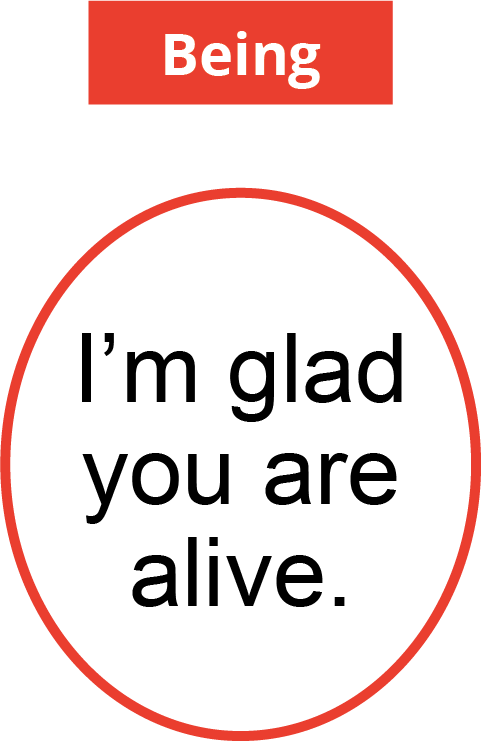 I then did what I have done many times before when I first learned of the death of a family member or a friend. While my mouth was still in denial, “This couldn’t be true,” part of my brain started making a coping list. “Let’s see, this is Wednesday, the funeral won’t be until Saturday because he has a brother in the Marines and they’ll have to get him home. Who are the people I should call? I must remember to order flowers, etc.” These two things going on simultaneously were familiar to me, but with Eric, there was added a third dimension that was very different. Way back in my head a choir of angels, with the most gorgeous voices you can imagine, started to sing. You can guess what they were singing. “I’m glad you’re alive and knowing and growing. I love you very much. I’m glad you’re alive.” The song went on unbidden for about 20 minutes. Of course you know what it was about. While I was denying and while I was making my coping list, I was also celebrating that Wade was still alive, that on Saturday our family would go to the funeral and would walk out with a live son. Eric’s family would go home without their boy. After that experience I thought much more about how songs work and have noticed that songs can go straight to the heart and have a quality of circumventing the denying brain that spoken words do not have.
I then did what I have done many times before when I first learned of the death of a family member or a friend. While my mouth was still in denial, “This couldn’t be true,” part of my brain started making a coping list. “Let’s see, this is Wednesday, the funeral won’t be until Saturday because he has a brother in the Marines and they’ll have to get him home. Who are the people I should call? I must remember to order flowers, etc.” These two things going on simultaneously were familiar to me, but with Eric, there was added a third dimension that was very different. Way back in my head a choir of angels, with the most gorgeous voices you can imagine, started to sing. You can guess what they were singing. “I’m glad you’re alive and knowing and growing. I love you very much. I’m glad you’re alive.” The song went on unbidden for about 20 minutes. Of course you know what it was about. While I was denying and while I was making my coping list, I was also celebrating that Wade was still alive, that on Saturday our family would go to the funeral and would walk out with a live son. Eric’s family would go home without their boy. After that experience I thought much more about how songs work and have noticed that songs can go straight to the heart and have a quality of circumventing the denying brain that spoken words do not have.
What You Need Is Important
 Another song experience occurred on a day that a song told me what to say. I was talking with Troy, a young editor who was working on the “Growing Up Again” book. We were pushing each other to wrap up some final adjustments so the book could go to print. It was Monday morning, we were on the phone, and the conversation was not going well. I kept hearing the song, “What you need is important” in the back of my head — “What you need is important, important, important. What you need is important, very important to me,” over and over again. I thought, “What is this about?” So I asked Troy, “Is there something you need today?” He responded in a startled voice, “Why do you ask?” I countered with, “Oh, I was just wondering if there was something you need.” He sighed, “Well, yes. There is a lot that I need. I came into work very tired because I had moved to a new apartment this weekend, and when I got here I found that my office had been moved from one room to another. All of my things had been picked up and just dumped into an empty office and I can’t find anything.” I offered, “How would it be if you took half an hour just to sort a few things out and then call me back?” “Oh, would you mind? Oh, that would be wonderful. I don’t know how you knew to ask that, but thanks.”
Another song experience occurred on a day that a song told me what to say. I was talking with Troy, a young editor who was working on the “Growing Up Again” book. We were pushing each other to wrap up some final adjustments so the book could go to print. It was Monday morning, we were on the phone, and the conversation was not going well. I kept hearing the song, “What you need is important” in the back of my head — “What you need is important, important, important. What you need is important, very important to me,” over and over again. I thought, “What is this about?” So I asked Troy, “Is there something you need today?” He responded in a startled voice, “Why do you ask?” I countered with, “Oh, I was just wondering if there was something you need.” He sighed, “Well, yes. There is a lot that I need. I came into work very tired because I had moved to a new apartment this weekend, and when I got here I found that my office had been moved from one room to another. All of my things had been picked up and just dumped into an empty office and I can’t find anything.” I offered, “How would it be if you took half an hour just to sort a few things out and then call me back?” “Oh, would you mind? Oh, that would be wonderful. I don’t know how you knew to ask that, but thanks.”
I Love You When You’re Active and When You’re Quiet
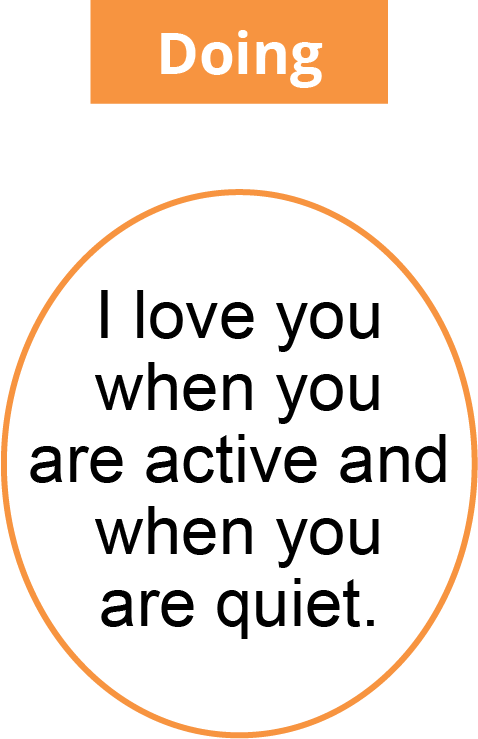 Other people have reported similar experiences where a song has popped up in their heads to help them solve a problem or to fortify an intuition. I also had an interesting healing experience with one of the songs. I had been doing a spot of therapeutic work on the issue of over-scheduling. I wasn’t thinking about that as I entered my car for an hour-long drive to a meeting. I recall slipping the affirmation tape into the player and fast forwarding to the song “I love you when you’re active and when you’re quiet” because I had wanted to sing it at a workshop and I couldn’t remember it all.
Other people have reported similar experiences where a song has popped up in their heads to help them solve a problem or to fortify an intuition. I also had an interesting healing experience with one of the songs. I had been doing a spot of therapeutic work on the issue of over-scheduling. I wasn’t thinking about that as I entered my car for an hour-long drive to a meeting. I recall slipping the affirmation tape into the player and fast forwarding to the song “I love you when you’re active and when you’re quiet” because I had wanted to sing it at a workshop and I couldn’t remember it all.
I found the spot on the tape. I listened to the song, and then turned the tape off and tried to sing it. I couldn’t remember it. I did this several times. Irritated, I determined that I would listen to it enough times to learn it. That didn’t seem to work. I wondered why I couldn’t learn it. I decided that it was the fault of the song. Darrell had written a song in which the intervals were too difficult to sing. I listened carefully and the intervals were not too difficult. Then I decided that Darrell had written a song that didn’t flow well. I listened again; it flowed. I sang it out loud, very loud, and I realized, as I listened to myself, that I had changed the words! The song is: “I love you when you’re active and when you’re quiet too. Busy, busy, busy or very quiet. I love you, yes I do.” I was singing it: “I love you when you’re active and when you’re active too. Busy, busy, busy or very active, I love you, yes I do.” I was amazed! The difficulty I had been having with over-scheduling was probably echoing my growing-up situation which I had just sung about. My mother was uncomfortable if children were quiet. If my brother and I were quiet she would call to us from the next room, “What are you doing? What kind of mischief are you in? Why are you quiet?” We even learned to color noisily! When I tried to sing the song again in the correct way, it was very hard to get out those quiet words. I used the help from the song to finish off that piece of healing very quickly.
Growing Up Again
The affirmations are an integral part of the book “Growing Up Again: Parenting Ourselves, Parenting Our Children” which I wrote with Connie Dawson, published in 1989. Connie and I hope that this is the bridge book between self-help books and parenting books. Our premise is that adults need to be careful not to neglect themselves while they are raising their children, and not to neglect their children while they are doing their own recovery or healing or growing up again. The affirmations are featured in the dual use of programming for children and as support for recycling adult needs.
There are seven charts in the “Growing Up Again” book, one for each developmental stage: Being, Doing, etc. Each chart offers concise but thorough information on psychosocial growth for that stage. The affirmations support the interrelated jobs of the child, helpful parent behaviors, and activities that reinforce the adults in their recycling or growing up again. There have been many requests for permission to copy these charts or to include them in other parenting programs.
The affirmations are also a regular part of the activities presented in the “Growing Up Again Leader Guide” (1981).
Video Tapes
In 1991, I got a call from Marilyn Cohen saying that the University of Washington’s Telecommunications Center was going to produce a set of video tapes for use with Spanish-speaking migrant workers. These tapes would be the first that were produced in the United States in Spanish featuring people whose first language was Spanish. Previous films had been made in English with a Spanish voice overlay or Spanish subtitles. Would I like to be a consultant to the project? Of course I was delighted to. One of the things that pleased me was the plan to base the videos on my work, not to translate directly. Marilyn wanted to use the developmental approach and the affirmations. Estela Carrera Plotz, with the help of several other people, started the translation of the affirmations. Estela, who was a trained “Self-Esteem: A Family Affair” facilitator, starred in the films. The project was named “Platica de Autoestima.”
In 1993, a leader guide to go with the films was completed. Estela, Nat Houtz, Kate Calhoun, and Carmen Michelson created the guide, and Teresa Ruiz de Somocurcio-Kamrath did the final editing and was responsible for the completion of that project. Carole Gesme published the affirmations in Spanish for her class, so participants now have a choice of English or Spanish affirmation ovals.
Also in 1993, Marilyn Cohen and the Telecommunications Center created four videos based on “Growing Up Again.” Those videos feature the affirmations in English.
Readers of “Growing Up Again” identified with the chapter on overindulgence and asked for more information. In answer to that call, Dr. David Bredehoft, Dr. Connie Dawson and I launched the Overindulgence Research Project in 1996. The findings from the Overindulgence Research Project were published in “How Much is Enough? Everything You Need to Steer Clear of Overindulgence and Raise Responsible and Respectful Children” (2003) and revised in “How Much is Too Much? Raising Likeable, Responsible, Respectful Children in the Age of Overindulgence” (2014). The Developmental Affirmations are embedded in the “How Much is Too Much” book and leaders guide as a guide to raise competent, capable, and resilient children while avoiding overindulgence and spoiling.

Feedback/Errata